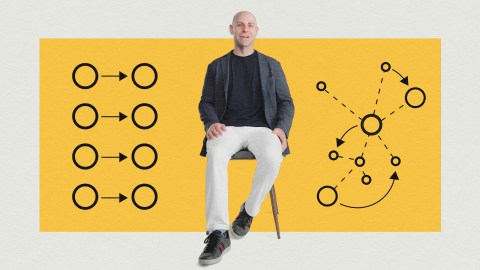Adam Grant on how to identify and develop high-potential leaders

The quest to build a robust pipeline of high-potential leadership talent is increasingly urgent as the challenges facing organizations gain in complexity and speed. However, the current leadership gap illustrates how difficult that quest can be.
One crucial question must be addressed at the outset: What differentiates high-potential leadership talent from high-performing professionals more generally? Both are essential to an organization’s success, but each brings unique capabilities.
Too often, high-potential leaders are identified by “I know it when I see it.” Not only does this approach open the door to bias and run the risk of overlooking hidden talent, but the lack of clarity limits the organization’s ability to develop a future-ready leadership cadre.
But what leadership skills take priority? Psychologist and science journalist Adam Grant pinpoints one of the most critical and over-arching for today’s turbulent times — strategic problem-solving.
According to Grant, “Often our highest potential people are the ones who can diagnose a problem that nobody else has seen and then figure out how to tackle it.” The challenge is to recognize the potential for that capability when assessing future leadership talent.

Building capability along the abstract-concrete continuum
Every organization blends “big picture” strategists with people who delight in the details, and this synergy between abstract and concrete thinking is essential — first to envision the future and then actually make things happen. It’s here that strategic thinking and problem-solving capabilities come into play. But as Grant asserts, high-potential, strategic problem-solvers aren’t limited to one type of thinking. They have the ability to “toggle back and forth.”
Why is that important? As Grant states, “There are a lot of people with strong leadership potential who excel at abstract thinking, but they really struggle when it comes to making ideas concrete.” At the same time, “You may also have some people who tend to be much more concrete,” but who can easily get “stuck in the weeds,” which limits their ability to imagine new possibilities. Skillful strategic thinkers have the capability to bring both perspectives into play.
Grant points out that identifying people who can combine both abstract and concrete thinking isn’t always easy. While some will be among the fortunate who can already demonstrate the “toggling” behavior he describes, other high-potential employees will bring strengths in one area while needing to stretch in the other. As such, developing the capacity for strategic decision-making requires more than a one-size-fits-all approach.
It’s also important to remember that a particular way of thinking isn’t necessarily static. Coaching and directed exercises can make a difference.
So, how can someone who excels at abstract thinking improve their ability to make their ideas more concrete? Grant references research from Wharton School colleague, Drew Carton, describing mental time travel. The concept is to look ahead 5–10 years and imagine your vision and strategy have been realized. Then “paint a picture” of what is different or disrupted in the organization, industry, and market. As the broader vision acquires specifics, the abstract thinker can more effectively convey their ideas to others.
What about the reverse? How can someone who excels at concrete thinking improve their ability to think abstractly? Grant suggests conducting a pre-mortem, a technique initially developed by research psychologist Gary Klein. People come together on the assumption that a planned strategy has failed. They then work to identify the likely causes, missed threats, and misread opportunities before considering how to avoid similar mistakes in the future. The exercise pushes people to “think more broadly and deeply about the possibilities on the table” and begin to transition toward a more abstract perspective.
“We live in a world that’s obsessed with raw talent. We admire child prodigies in music, natural athletes in sports, geniuses in school, but focusing on where people start causes us to overlook the distance that they’re capable of traveling,” Grant reminds us.
Tailor learning opportunities to real-world challenges
A development strategy for strategic decision-making will need the flexibility to accommodate high potentials along the abstract-concrete continuum. To start, it can be helpful to isolate several critical sub-skills. For example, business acumen, collaboration, problem-solving, and initiative are core behaviors for strategic decision-making that can be assessed and targeted for development.
A solid foundation for many of these skills can be built through a combination of coursework, group learning, coaching, and targeted experiences. For example, a workshop on business acumen could be supplemented with a mental time travel exercise. A session focused on collaboration could be tied to a pre-mortem. Central to these exercises is small group interaction that pulls every person into the analysis and ideally flexes underused mental muscles.
Perhaps most critical for the transfer of learning is the opportunity to practice and demonstrate capabilities on the job. A personalized development plan for each high-potential leader should include carefully targeted assignments and responsibilities, reinforced by coaching and feedback, that provide real-world learning opportunities.
Final thoughts
Strategic problem-solving is a highly complex skill, hence its importance in distinguishing high-potential leaders. That degree of complexity, however, also requires substantial rigor in an organization’s approach to assessment and development.
Take the example of Grant’s abstract-concrete continuum. Who is responsible for assessing where someone falls and what criteria are used? Based on that assessment, what are relevant development opportunities? For intensive work sessions such as mental time travel or a pre-mortem, who will be tapped to lead them? How will a high-potential’s progress and future development needs be identified and discussed?
At the end of the day, an organization’s success at building its strategic problem-solving capabilities rests not only on its ability to identify its highest potential leaders but more crucially on the rigor of its development approach and long-term commitment.





